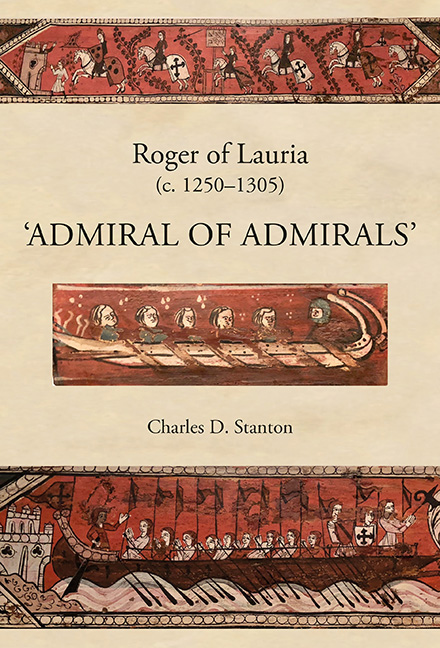Book contents
- Frontmatter
- Dedication
- Contents
- List of Illustrations
- Prologue
- 1 Battle of Benevento (26 February 1266)
- 2 A Calabrian Exile in the Court of Aragon (1262–1282)
- 3 Battle of Tagliacozzo (23 August 1268)
- 4 Aragonese Expansion (1229–1282)
- 5 Angevin Consolidation and Aggrandizement (1268–1282)
- 6 Revolt of the Vespers (30 March 1282)
- 7 Aragonese Intervention (August–October 1282)
- 8 Stalemate (November 1282–March 1283)
- 9 Admiral of Aragon (20 April 1283)
- 10 The Opposing Fleets (1282–1302)
- 11 Battle of Malta (8 June 1283)
- 12 Anjou's Dreams of Empire Dashed (June–November 1284)
- 13 France's Crusade Against Aragon (May–November 1285)
- 14 Battle of the Counts (23 June 1287)
- 15 Truces and Treaties (June 1287–November 1291)
- 16 Raid on Romania (Summer 1292)
- 17 Switching Sides (December 1293–April 1297)
- 18 Aragon's Invasion of Sicily at Anjou's Bidding (1298/1299)
- 19 Lauria's Last Great Campaign (Summer 1299–Spring 1300)
- 20 Endgame (Spring 1301–Summer 1302)
- Epilogue
- Bibliography
- Index
6 - Revolt of the Vespers (30 March 1282)
Published online by Cambridge University Press: 24 October 2019
- Frontmatter
- Dedication
- Contents
- List of Illustrations
- Prologue
- 1 Battle of Benevento (26 February 1266)
- 2 A Calabrian Exile in the Court of Aragon (1262–1282)
- 3 Battle of Tagliacozzo (23 August 1268)
- 4 Aragonese Expansion (1229–1282)
- 5 Angevin Consolidation and Aggrandizement (1268–1282)
- 6 Revolt of the Vespers (30 March 1282)
- 7 Aragonese Intervention (August–October 1282)
- 8 Stalemate (November 1282–March 1283)
- 9 Admiral of Aragon (20 April 1283)
- 10 The Opposing Fleets (1282–1302)
- 11 Battle of Malta (8 June 1283)
- 12 Anjou's Dreams of Empire Dashed (June–November 1284)
- 13 France's Crusade Against Aragon (May–November 1285)
- 14 Battle of the Counts (23 June 1287)
- 15 Truces and Treaties (June 1287–November 1291)
- 16 Raid on Romania (Summer 1292)
- 17 Switching Sides (December 1293–April 1297)
- 18 Aragon's Invasion of Sicily at Anjou's Bidding (1298/1299)
- 19 Lauria's Last Great Campaign (Summer 1299–Spring 1300)
- 20 Endgame (Spring 1301–Summer 1302)
- Epilogue
- Bibliography
- Index
Summary
LA CHIESA DELLO SPIRITO SANTO (‘the Church of the Holy Spirit’) sits in a serene setting on the outskirts of Palermo (Fig. 4). It is perched just a few hundred yards southeast of the old city walls on the left bank of a lushly foliated ravine through which runs the River Oreto. All around it are the gravestones, mausoleums and sepulchral monuments of the eighteenth-century Cimitero di Sant'Orsola (‘Cemetery of Saint Ursula’), interspersed here and there with ancient cypress trees. But in the spring of 1282, the Camposanto di Santo Spirito, as the cemetery is now officially known, was a grassy field covered with vernal blossoms. There could have been nothing in this peaceful scene that would have predicted the eruption of unfettered violence that took place there on the evening of 30 March, the day after Easter – save, perhaps, the dour Norman ecclesiastical edifice itself. Founded in 1178 as an ascetic Cistercian abbey, the Arabo-Norman structure with blind gothic arches and arabesque motifs was built with blocks of tuff stone and lava rock, forming alternating horizontal veins of ochre and grey that give it a grim, austere aspect. Ominously, Walter of the Mill, an English-born archbishop, had laid the foundation stone on the day of a solar eclipse.
THE SPARK
Contemporary chroniclers offer several versions of what happened there some seven centuries ago, but a basic outline of the events is common to all. The account of Sicilian patriot Bartolomeo di Neocastro seems the fullest and most credible. It was tradition at the time for a festival to be held on the grounds of the church on Easter Monday, so the piazza in front of the entrance was filled with city-dwellers and villagers, making merry while waiting for Vespers (evening prayers) at sunset. Amid the singing, dancing and drinking of this convivial scene strolled a group of French soldiers, several of whom were already inebriated. One of their number, a sergeant whom the sources identified as Drouet, pulled a pretty young noblewoman out of the crowd and apparently fondled her on the pretext of searching for arms. The fact that his name was known indicates that he was probably a recidivist offender. In any event, this act of boorish behaviour would be his last.
- Type
- Chapter
- Information
- Roger of Lauria (c.1250–1305)‘Admiral of Admirals’, pp. 79 - 89Publisher: Boydell & BrewerPrint publication year: 2019

